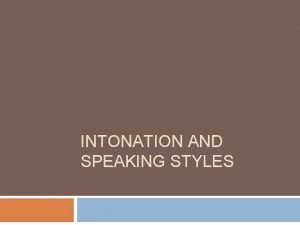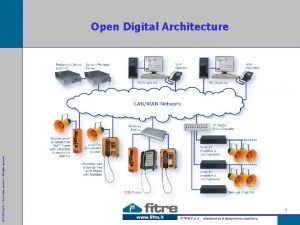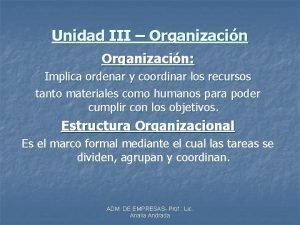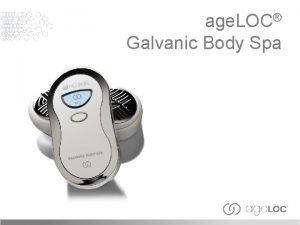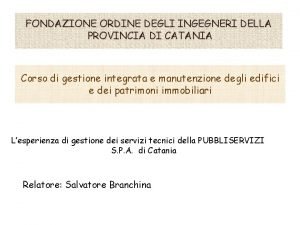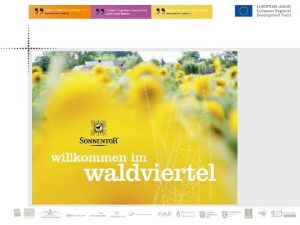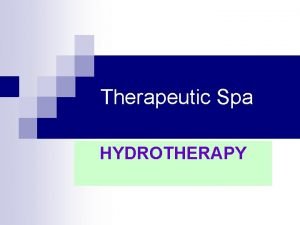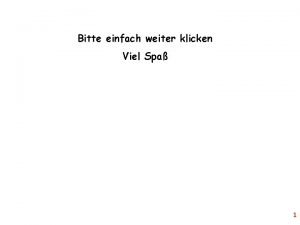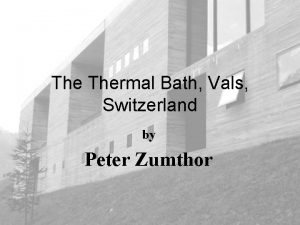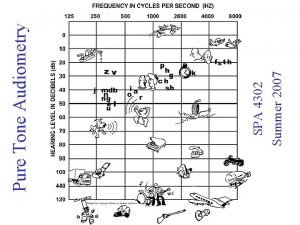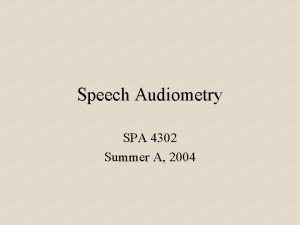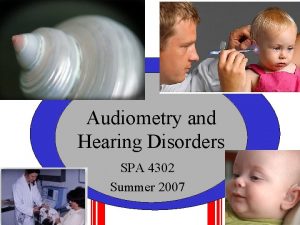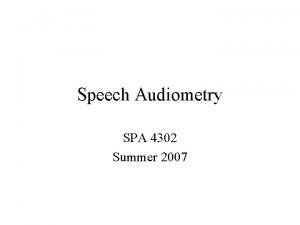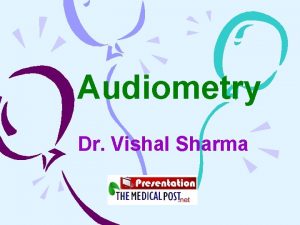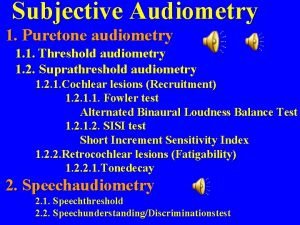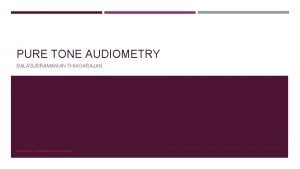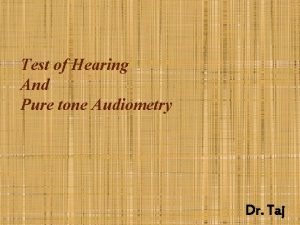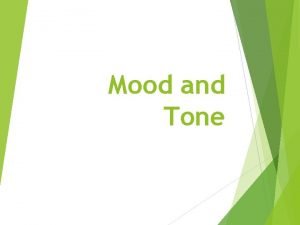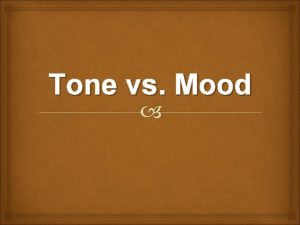Pure Tone Audiometry SPA 4302 Summer A 2004
























- Slides: 24

Pure Tone Audiometry SPA 4302 Summer A, 2004

The Pure-Tone Audiometer • Electronic device that generates tones for determining hearing thresholds • Manufactured to specifications of the American National Standards Institute (ANSI) • Air/Bone Conduction • Testable frequencies (A/C): 125, 250, 500, 750, 1000, 1500, 2000, 3000, 4000, 6000, 8000 Hz • Testable frequencies (B/C): 250 through 4000 Hz • Masking control available

Test Environment • Background noise may affect audiometric results by elevating thresholds • Three ways room noise may be attenuated • Earphone enclosure device • Insert earphones – foam tipped receivers that are inserted directly into the ears • Sound isolated chambers

The Patient’s Role • Patients must be aware that they are to indicate when they hear a tone • Patient response: hand raise, finger raise, signal button, vocal response, play • False responses – False negatives: patient fails to indicate when they’ve heard a tone - misunderstood or forgotten instructions, feigning or exaggerating loss – False positives: patients responds when no tone is presented – usually occurs when there are long silent periods in the test

The Clinician’s Role • Convey task instructions to patient • Ensure understanding • Patient position – Position patient so they cannot observe the clinician’s movements

Air-Conduction Audiometry • Specifies hearing sensitivity at various frequencies • Can’t tell whether deficit is conductive or sensorineural, or mixed • Earphone placed with diaphragm aimed directly over canal opening • Be careful of canals that collapse due to the pressure of the earphones – use insert earphones if this is a potential problem

Air-Conduction Audiometry • Test the known or suspected better ear first • Test at the octave points and the mid-octaves (750, 1500, 3000, 6000 Hz) if there is a difference of 20 d. B or more between adjacent octaves • Begin at 1000 Hz – easily heard by most and high test-retest reliability

Measuring a Threshold • Start presenting pure tones at 30 d. B HL – No response? Raise the level to 50 d. B HL – Still no response? Raise the level in 10 d. B increments • Whenever person responds, lower the level 10 d. B • Whenever no response, raise the level in 5 d. B • Threshold=the lowest level at which the patient can correctly identify the tone presentation at least 50% of the time, with a minimum of 3 responses at a given level.

Air-Conduction Audiometry • Pure-tone average (PTA)=average of air conduction thresholds obtained at 500, 1000, and 2000 Hz in one ear – Useful for predicting threshold for speech • Percentage of Hearing Impairment – Ignores audiometric configuration and looks only at average hearing loss – Often confusing and misleading to patients

Air-Conduction Audiometry PTA (d. B) Degree of Communication Impact 0 -15 16 -25 26 -40 41 -55 56 -70 71 -90 > 91 None Slight Mild Moderately Severe Profound

Air-Conduction Audiometry • The Audiogram – Frequency (in hertz) on the x-axis, Intensity (in d. B HL) on the y-axis – Moving left to right, frequency increases; moving top to bottom, intensity increases – Symbols are placed to correspond to threshold at a given frequency: Air conduction Bone conduction Air—Masked Bone—Masked Right O Left X < > [ ]

The Audiogram • Thresholds by frequency • Hearing by air and bone transmission

Severity of Hearing Loss

Bone-Conduction Audiometry • 3 Mechanisms of Bone Conduction – Distortional Bone Conduction – Inertial Bone Conduction – Osseotympanic Bone Conduction • Bone Oscillator Placement Mastoid process, or, Forehead

Bone-Conduction Audiometry • Occlusion Effect – When the ears of patients with normal hearing or SNHL are covered or occluded, there is an increase in intensity of sound delivered via a bone oscillator – Affects 1000 Hz and below – Result of increase in SPL in the ear canal when the outer ear is covered – Markedly decreased when insert phones are used (as opposed to supra-aural headphones)

Bone-Conduction Audiometry • No matter where the oscillator is placed, you can never be sure which cochlea is being stimulated! (more on this to come) • Frequencies usually tested: – 250, 500, 1000, 2000, and 4000 Hz • Symbols for bone conduction are only connected on the audiogram (with dashed lines) when there is a conductive or mixed loss.

Audiogram Interpretation Look at: • hearing sensitivity by AC • hearing sensitivity by BC • AC/BC difference (a. k. a. the air-bone gap) No air-bone gap = normal or SNHL AC worse than BC = conductive hearing loss • Watchout: low frequencies at high levels via BC can be perceived as a tactile signal!


Another Thing to Watch Out For: • Cross Hearing: sound delivered to one ear but perceived in the other ear. • Interaural Attenuation (IA)—How much sound it takes to reach the other side: – Air conduction IA = 40 d. B – Bone conduction IA = 0 d. B • Danger for cross-hearing – For AC—If AC threshold in the test ear, minus IA, is greater than or equal to the BC threshold of the opposite ear – For BC—If Air-bone gap of test ear exceeds 10 d. B

Masking • Masking—keeping the non-test ear “busy” in order to ensure that it is actually the test ear which is responding • Noises used to mask: – White noise—has approximately equal energy per cycle & covers a broad range of frequencies – Narrowband noise—made up of frequencies that immediately surround the pure tone being tested • Insert earphones recommended because: – They lessen the occlusion effect – They provide much more interaural attenuation

Effective Masking: Calibration of the noise • d. B EM (Effective Masking) describes the level to which a threshold will shift in the presence of a given level of noise • So, 45 d. B EM should raise threshold for a tone to 45 d. B HL in the ear in which both are presented.

Masking • Masking for air conduction – “Shotgun” Approach – Minimum-noise method – Maximum-noise method – Plateau method • Masking for bone conduction – Similar to air conduction – Beware of occlusion effect, and overmasking

Computerized Audiometry • Using a device remotely operated by a computer and data is stored • Computer can control all aspects of testing and masking and analyze patient responses • Used more often for military, industrial, and educational applications (large number of people to test)

 Otosclerosis flamingo pink blush
Otosclerosis flamingo pink blush Examples of informal tone
Examples of informal tone Informal tone
Informal tone What is falling intonation
What is falling intonation Fitre fox
Fitre fox Camhs spa surrey
Camhs spa surrey Tragus duvar mesafesi
Tragus duvar mesafesi Departamentalizacion por clientes
Departamentalizacion por clientes Dogso i spa
Dogso i spa How does the galvanic body spa work
How does the galvanic body spa work Pubbliservizi spa
Pubbliservizi spa Spa schema riassuntivo
Spa schema riassuntivo Orangi spa
Orangi spa Spa personalmanagement
Spa personalmanagement Spa objectives
Spa objectives Spa tourism definition
Spa tourism definition Resta s
Resta s Autovie venete spa
Autovie venete spa Interview spa
Interview spa Jjq spa
Jjq spa Spa negotiation
Spa negotiation The pudding lab
The pudding lab Pearson italia spa
Pearson italia spa Epoaf
Epoaf Thermal bath vals
Thermal bath vals



